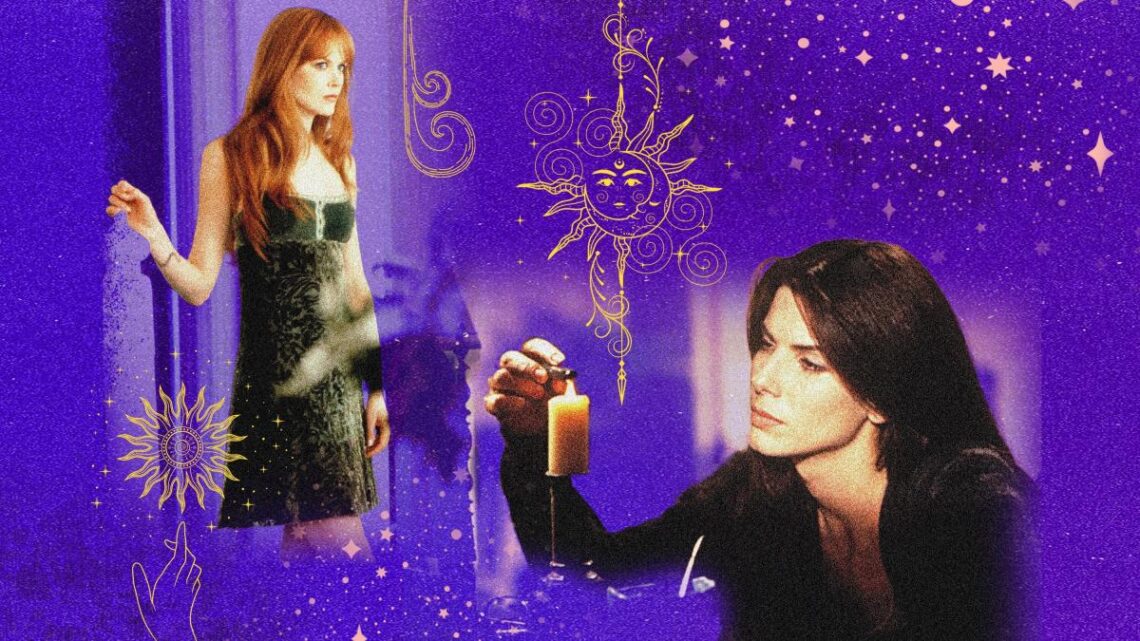What do crushed velvet, celestial motifs and Practical Magic stars Sandra Bullock and Nicole Kidman have in common? They encompass an ultra-specific and ultra-moody aesthetic that many Gen Z-ers and millennials find themselves spellbound by come fall: whimsigoth.
Coined by architectural designer Evan Collins in 2020 as “whimsigothic” and eventually shortened to “whimsigoth,” the aesthetic, as its name suggests, is a blend of whimsical and gothic styles. The aesthetic first arose in the late ’80s, peaked in the early to mid ’90s and practically disappeared by the new millennium.
“At the time, I was just calling it ‘whimsical, mystical, gothic, celestial,’” Collins, who is a founder of the Consumer Aesthetics Research Institute, told Yahoo Entertainment. “[Whimsigoth] seemed to be the best fit for what I was looking at, with the gothic influence of having this dark and moody side and incorporating heavy metals and mystical imagery and iconography … but then mixing in all of this very playful, celestial imagery.”
Plush seating, sheer and lace fabrics, tapered candles, curly, wrought iron furniture and tarot iconography are often found in whimsigoth homes. The average whimsigoth enthusiast likely watches Tim Burton films, lusts over Thierry Mugler designs and has Mazzy Star on repeat. Though perhaps the most defining characteristic of the modern whimsigoth woman is her love of ’90s-era pop culture witches, like Practical Magic characters Sally and Gillian Owens.
The 1998 film, which was adapted from Alice Hoffman’s bestseller of the same name, has become synonymous with the dramatic and over-the-top aesthetic. In the romantic fantasy, Bullock and Kidman star as sisters who come from a long line of powerful female witches. While they manage to avoid practicing witchcraft most of their lives, the sudden death of Gillian’s abusive boyfriend forces them to tread the unfamiliar territory of darker, harder magic.
“There’s always a problem with anything created of, by and about women that sometimes is reduced. I think [Practical Magic] is claiming what goth is and what whimsy is, and what witches are,” Hoffman told Yahoo Entertainment. “In that way, I feel really good about it.”
Academy Award-nominated costume designer Judianna Makovsky and husband-and-wife production designers Robin Standefer and Stephen Alesch of Roman and Williams — who designed and crafted the film’s Victorian-era home — are largely responsible for cultivating Practical Magic’s coveted aesthetic. (“If I had dreamt up a house, it would have been the house that they created,” Hoffman said.)
In an interview with Elle, Makovsky, who also designed costumes for Great Expectations, The Hunger Games and a slew of Marvel movies, said she curated wardrobes that catered to the sisters’ “distinct” personalities.
Sally, the owner of a local botanical shop, wants to fit in with others in her town, so she often wears jeans and is more understated with her style. Makovsky even loaned her personal Blumarine sweater with velvet green embroidered leaves for Bullock’s character. Gillian, on the other hand, has more of a bad girl persona. She opts for sexier silhouettes like the Gen Z-beloved crushed velvet slip dress that was purchased from Fred Segal and then completely reworked to better fit Kidman in the film.
“When I’m writing, I’m writing the characters from the inside out. So I don’t see them in the same way. I don’t necessarily see them. I kind of am them. But if I had to bring them out of my mind and into a room, it would be exactly this,” Hoffman said of Makovsky’s wardrobe selections. “The kind of maxi skirts and the vintage pieces. It all felt a little bit hippie and a little bit modern.”
Sartorially speaking, whimsigoth heavily overlaps with the early to late ’90s aesthetic known as Renaissance Revival. (Think Shakespearean, Elizabethan and medieval-meets-’90s silhouettes and fabrics, per Collins.) Renaissance Revival fashion can be seen in Practical Magic and Shakespeare-adapted teen movies like 10 Things I Hate About You and Get Over It.
From a design point of view, Collins cites Grammy-winning artist Cher’s short-lived furniture and fashion catalog Sanctuary, which published just two editions in 1994 and 1995, as a perfect example of the aesthetic. He also encourages whimsigoth enthusiasts to look into the works of the “overlooked” designers who first conceptualized the style, including Mark Brazier-Jones, Garouste and Bonetti, as well as Margo Chase, who created the logo designs for Charmed and Buffy the Vampire Slayer.
Hailey Satersad, who describes herself as “your ’90s whimsical aunt,” posts videos of her celestial-themed bedroom on TikTok. Satersad has garnered more than 1.4 million likes on her whimsigoth room content.
“I always loved anything with suns and moons,” she said. “I remember a friend owned the classic ’90s celestial bedding and I was so jealous. I’ve always been drawn to super-cozy living spaces and places where it feels [like] people fully express themselves.”
Jonathan Carson, a TikTok creator known for his “Favorite Aesthetics” series, first came across whimsigoth when he was a kid in the ’90s at his neighbor’s house. (“That woman loved hues of royal blues, sun and moon motifs, violet crushed velvet and beaded doorways,” he said.)
“[Whimsigoth is] a lifestyle that channels creativity, divinity and a deep connection to the mystical. An infusion of everyday surroundings with a touch of magic. Practical Magic checks all the boxes when it comes to nostalgia, strong feminine energy, and it brings something very niche to the table,” he explained.
While there’s no definitive answer as to why whimsigoth is back and bigger than ever, Collins wonders if its rise in popularity may be linked to what he calls a “collective mourning.”
Design in the early ’80s, Collins notes, was characterized by a “bright excitement” that had noticeably dimmed by the end of the decade due to the AIDS crisis. Whimsigoth would become popular en masse just a few years later, which Collins suggests could have something to do with the general public gravitating toward the mystic or mythological as a way to cope with the effects of the epidemic.
Collins believes the coronavirus pandemic may have prompted a similar, societal gravitation toward the dark and light of whimsigoth.
“With the trauma of what everyone was going through at the time, there’s this kind of turn to the mystic or mythological as a way to mourn,” he explained. “I think in times of strife and stress, people want to move to something more comforting in a way.”




